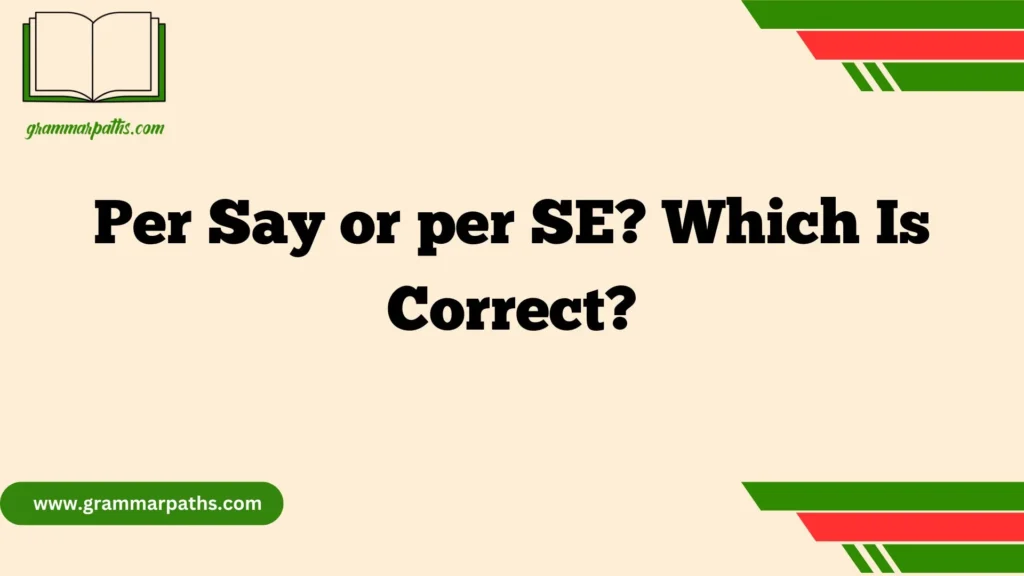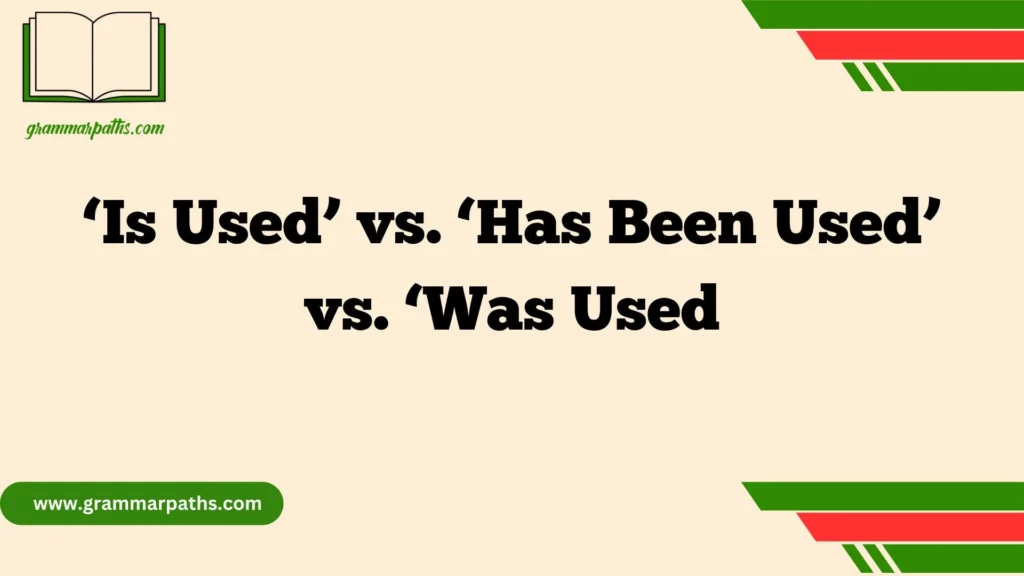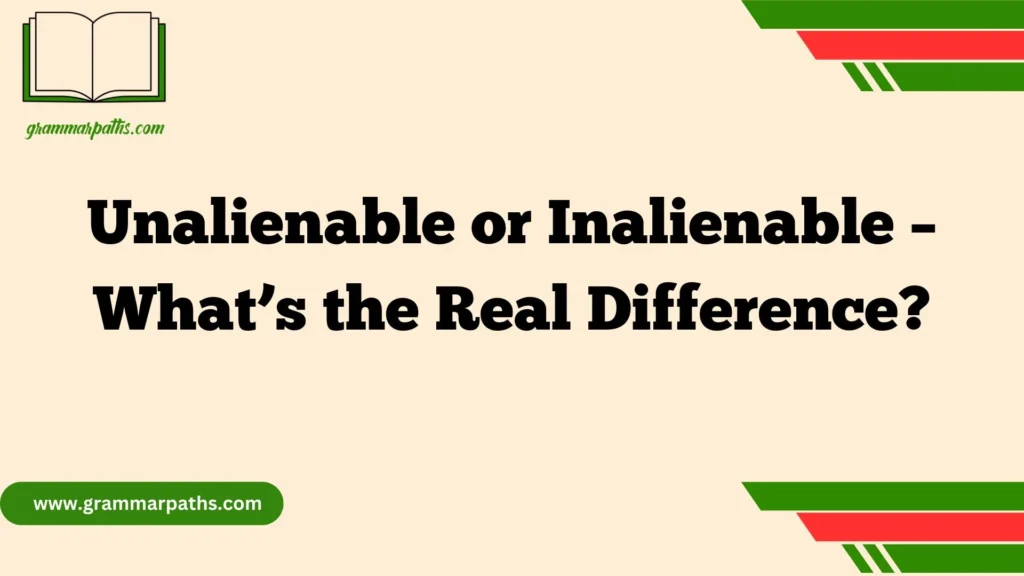Have you ever come across the phrase “per say” and wondered if it’s correct? You’re not alone. This confusion is surprisingly common. The real phrase is “per se”—a Latin term meaning “by itself” or “in itself.” It’s often used in both casual speech and formal writing to isolate the true nature of something. Unfortunately, many people mistakenly write it as “per say,” which is grammatically incorrect and doesn’t carry any meaning in English.
In this article, we’ll clear up the confusion around Per Say or Per Se, explain the origin of per se, and show you how to use it properly in sentences. We’ll also dive into common misuses, offer synonyms, and explore how this phrase differs from others like “necessarily” and “so to speak.”
What Does “Per Se” Actually Mean?
The Definition in Plain English
Per se means “in itself” or “by itself.” It’s used to emphasize that something is being considered in isolation, without other factors affecting it.
Examples:
- The movie isn’t bad per se, but it’s not my style.
- It’s not a scam per se, just misleading.
In both cases, per se helps highlight that the core thing isn’t necessarily wrong—it’s just being viewed in a certain light.
Where “Per Se” Comes From
The phrase per se comes from Latin. “Per” means “by” or “through,” and “se” means “itself.” Together, it translates to “by itself.”
Latin phrases like per se have survived in modern English because they offer precise ways to express ideas. You’ll still see them often in legal, philosophical, and formal writing.
Why “Per Say” Is Incorrect (and Why People Still Use It)
Phonetic Confusion
Here’s the problem: “Per se” and “per say” sound almost exactly the same. So people assume the latter is correct based on how it sounds. This kind of error is called an “eggcorn,” where a word or phrase is mistakenly used because it sounds right.
Other examples of eggcorns:
| Incorrect Phrase | Correct Phrase |
| For all intensive purposes | For all intents and purposes |
| Biting my time | Biding my time |
| Nip it in the butt | Nip it in the bud |
“Per say” is one of the most common eggcorns.
Is “Per Say” Ever Acceptable?
Nope. “Per say” is never correct in any context. It’s not a real phrase, just a misheard and misspelled version of per se.
The only correct form is “per se”—spelled s-e, not s-a-y.
How to Use “Per Se” Correctly in a Sentence
Real-Life Examples
Here are a few ways to use per se correctly:
- The app isn’t bad per se, but the user interface needs work.
- It’s not a breach of policy per se, though it might raise concerns.
- I don’t dislike him per se; we just have different styles.
Common Mistakes to Avoid
Many people throw in per se where it doesn’t belong or when it adds no real meaning. Use it only when you’re trying to isolate a thing on its own merits.
Incorrect:
“I’m not against the idea per se, but it’s just foolish.”
(Problem: If it’s foolish, then you are kind of against it.)
Better:
“I’m not against the idea per se, but the execution needs improvement.”
Alternatives and Synonyms for “Per Se”
Sometimes, per se can feel too formal. Depending on the tone you’re going for, there are several good alternatives:
| Alternative | Meaning | Example |
| In itself | On its own | The book isn’t interesting in itself. |
| By itself | Without outside influence | The idea by itself isn’t bad. |
| Essentially | At its core | The plan is essentially flawed. |
| Intrinsically | Naturally, inherently | It’s intrinsically valuable. |
| Technically | According to strict meaning | Technically, it’s not illegal. |
These can be used when you want a simpler or more casual alternative to per se.
“Per Se” vs. Other Confusing Phrases
Let’s clarify a few more common mix-ups.
“Per Se” vs. “Necessarily”
These words aren’t interchangeable, though they’re often confused.
- “Per se” focuses on something in isolation.
- “Necessarily” suggests something is inevitable or required.
Example:
- The law isn’t unfair per se, but its enforcement is problematic.
- Just because someone is late doesn’t necessarily mean they’re irresponsible.
“Per Se” vs. “So to Speak”
Another common mix-up.
- “Per se” = literally or technically.
- “So to speak” = metaphorically or loosely.
Example:
- He’s not a bad person per se, just misguided.
- She’s the queen of the company, so to speak.
Quick Grammar Guide: Where to Place “Per Se”
Here’s a short grammar tip list to help you use per se properly:
- It’s usually placed after the noun or phrase it refers to.
- No commas are needed before or after it.
- Italics are optional, though common in formal writing.
Correct placement:
- It’s not a problem per se.
- The software per se works fine.
You should avoid overusing it in one sentence or paragraph, or it may sound repetitive or forced.
How “Per Se” Is Used in Law, Media, and Culture
Legal Context
In legal writing, per se has a very specific meaning. It often appears in phrases like:
- Negligence per se – An act considered negligent because it violates a law.
- Illegal per se – Something that is inherently illegal, without needing further proof.
Example:
- Driving under the influence is considered a violation per se, even if no accident occurred.
This legal use reinforces the idea of something being wrong or unlawful on its own merits, without needing context.
Pop Culture and Media
You’ll also spot per se in editorials, interviews, and films. It adds a tone of formality or technical accuracy.
Example quotes:
- “I’m not a fan of pop music per se, but Taylor Swift is an exception.” – Anonymous interviewee
- “It’s not about money per se; it’s about respect.” – Movie character in a drama
Writers often use per se when they want to sound thoughtful or nuanced.
Why It Matters to Get “Per Se” Right
Language Precision Builds Credibility
Using the correct phrase shows you understand not just what you’re saying—but how to say it well. That matters, especially in business communication, academia, or anywhere professionalism counts.
Example:
- Incorrect: The contract isn’t valid per say.
- Correct: The contract isn’t valid per se.
That one small error can make a big impression.
Common Uses Today
You’ll find per se frequently in:
- Blog posts and opinion pieces
- Business presentations
- Academic essays
- Legal and government documents
If you’re a writer, speaker, student, or professional, using per se correctly adds polish to your language.
FAQ About “Per Se”
Sure! Here are clear, numbered answers for each question in simple, easy-to-read format:
1. Which is correct, per se or per say?
The correct phrase is per se (spelled s-e). Per say (s-a-y) is incorrect and simply a common mistake caused by mishearing or misunderstanding the Latin term.
2. Where do we use per se?
We use per se when we want to talk about something “by itself” or “in itself,” without considering other factors. It’s often found in formal writing, law, academic contexts, and everyday speech when isolating a specific quality or idea.
Example:
- The idea isn’t bad per se, but it needs better planning.
3. What does “at per se” mean?
The phrase “at per se” is not a correct or standard expression in English. If you’ve seen it somewhere, it might be a mistake or a misuse. The correct phrase to use alone is just “per se.”
4. What does “so per se” mean?
Like “at per se,” “so per se” is not a recognized or correct phrase in English. It likely results from combining “so” with “per se” incorrectly. The proper phrase is simply “per se.”
5. Why is it called per se?
Per se comes from Latin, where “per” means “by” or “through” and “se” means “itself.” Together, it literally means “by itself” or “in itself.” It’s called that because it emphasizes the inherent nature of something without outside influence.
Final Takeaways: “Per Se” vs. “Per Say”
Understanding the difference between “per say” and “per se” might seem minor, but it can have a big impact on how polished and credible your writing sounds. “Per se” is the correct phrase—rooted in Latin, meaning “by itself” or “in itself.” It’s commonly used to clarify that something is being considered in isolation, apart from surrounding circumstances.
On the other hand, “per say” is a common mistake. It doesn’t exist in proper English and should always be avoided. Whether you’re writing an academic essay, a professional email, or just trying to sound clearer in everyday speech, knowing how and when to use per se correctly is a small but powerful skill.












